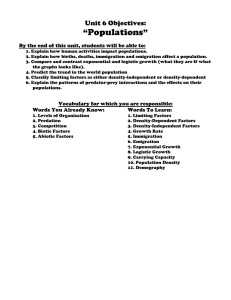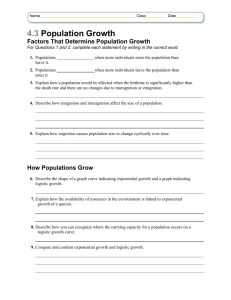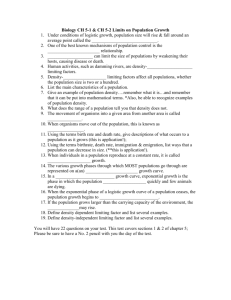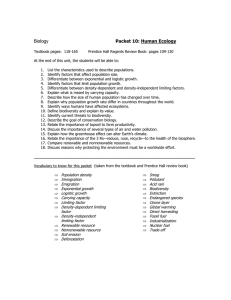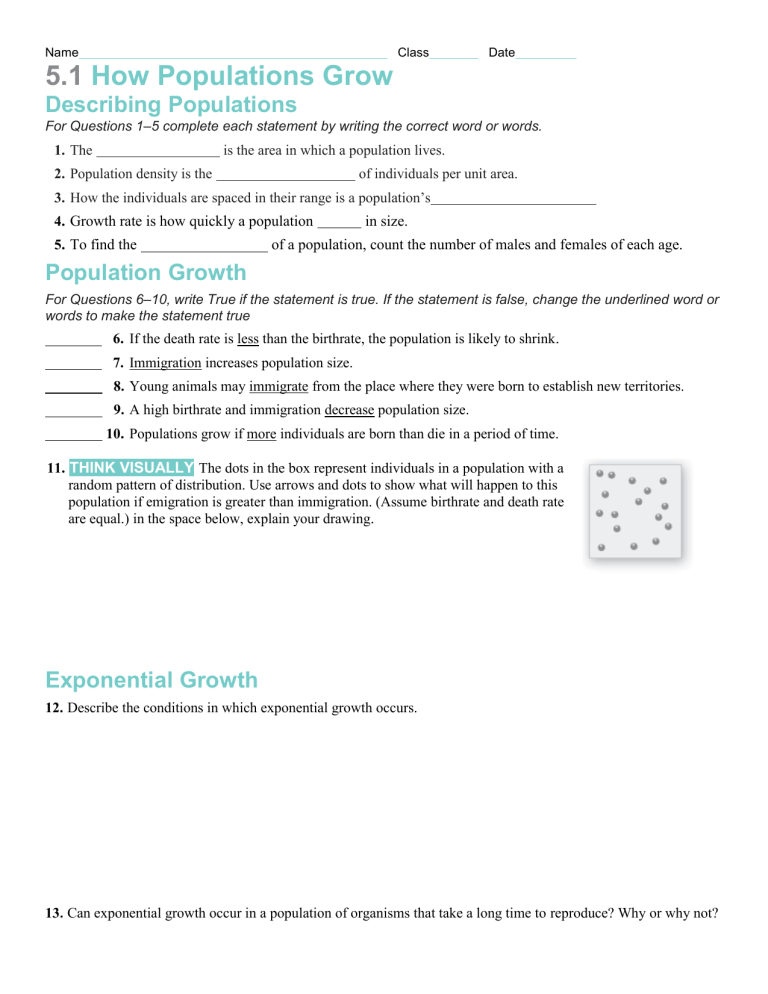
Name Class Date 5.1 How Populations Grow Describing Populations For Questions 1–5 complete each statement by writing the correct word or words. 1. The is the area in which a population lives. 2. Population density is the of individuals per unit area. 3. How the individuals are spaced in their range is a population’s 4. Growth rate is how quickly a population 5. To find the in size. of a population, count the number of males and females of each age. Population Growth For Questions 6–10, write True if the statement is true. If the statement is false, change the underlined word or words to make the statement true 6. If the death rate is less than the birthrate, the population is likely to shrink. 7. Immigration increases population size. 8. Young animals may immigrate from the place where they were born to establish new territories. 9. A high birthrate and immigration decrease population size. 10. Populations grow if more individuals are born than die in a period of time. 11. THINK VISUALLY The dots in the box represent individuals in a population with a random pattern of distribution. Use arrows and dots to show what will happen to this population if emigration is greater than immigration. (Assume birthrate and death rate are equal.) in the space below, explain your drawing. Exponential Growth 12. Describe the conditions in which exponential growth occurs. 13. Can exponential growth occur in a population of organisms that take a long time to reproduce? Why or why not? 14. Complete the graph by drawing the characteristic shape of exponential population growth. 15. What letter is used to refer to the characteristic shape of an exponential growth curve? Logistic Growth 16. Complete the graph by drawing the characteristic shape of logistic population growth. 17. What letter is used to refer to the characteristic shape of the logistic growth curve? 18. When real-world populations of plants and animals are analyzed, why do they most often have the logistic growth curve? 19. What does the term carrying capacity refer to? 20. Complete the table to name and explain three phases of logistic growth. Use the terms growth rate, population size, and carrying capacity in your explanations. Phases of Logistic Growth Phase Phase name Explanation 1 2 3 5.2 Limits to Growth Limiting Factors For Questions 1–6, write True if the statement is true. If the statement is false, change the underlined word to make the statement true 1. Limiting factors determine the immigration capacity of a population. 2. A limiting factor controls the growth of a population. 3. Limiting factors operate when growth is exponential. 4. Populations grow too large in the absence of limiting factors. 5. Competition is an example of a limiting factor. 6. Population size can be limited by factors such as predation. Density-Dependent Limiting Factors 7. What is a density-dependent limiting factor? 8. When do density-dependent factors operate most strongly? 9. What are four density-dependent limiting factors? Use the graph to answer Questions 10–13. 10. What happened to the number of wolves on Isle Royale between 1975 and 1985? 11. What happened to the moose population when the number of wolves was low? 12. What is the relationship between the moose and the wolves on Isle Royale? 13. Is the number of moose on the island a density-dependent or density-independent limiting factor for the wolf? Explain your answer. Density-Independent Limiting Factors 14. What term describes a limiting factor that affects all populations in similar ways, regardless of population size? Population Size 15. What is the usual response in the population size of many species to a density-independent limiting factor? 16. Complete the graphic organizer with examples of densityindependent limiting factors. can be limited by density-independent factors such as Name Class Date 5.3 Human Population Growth Historical Overview For Questions 1–5, write True if the statement is true. If the statement is false, change the underlined word or words to make the statement true. 1. Over the last 1000 years, the size of the human population has decreased. 2. Since the 1800s, human population growth has been logistic. 3. The human population has increased because birthrates have dropped. 4. The combination of low death rates and high birthrates led to exponential growth. 5. Charles Darwin suggested that human populations are regulated by war, famine, and disease. 6. Complete the table below to explain how each factor affected the size and growth rate of the human population over the last 10,000 years. Factors That Affected Human Population Growth Cause Agriculture Improved health care and medicine Improved sanitation Bubonic plague Industrial Revolution Effect Patterns of Human Population Growth 7. THINK VISUALLY Complete the diagram below by adding the information for stages II and III of the demographic transition. Draw bars to represent the birthrate and the death rate and describe the stages on the lines provided. Stage I is done for you. Use these age structure diagrams to answer Questions 8–11. 8. Which country has gone through the demographic transition? How do you know? 9. Which country do you predict will experience a slow and steady growth rate in the near future? Why? 10. Which country is most likely to grow exponentially in the near future? Why? 11. Suggest three factors that might slow population growth in Rwanda. 12. Explain why human population size is likely to increase in the twenty-first century, but not as rapidly as it did in the twentieth century.
